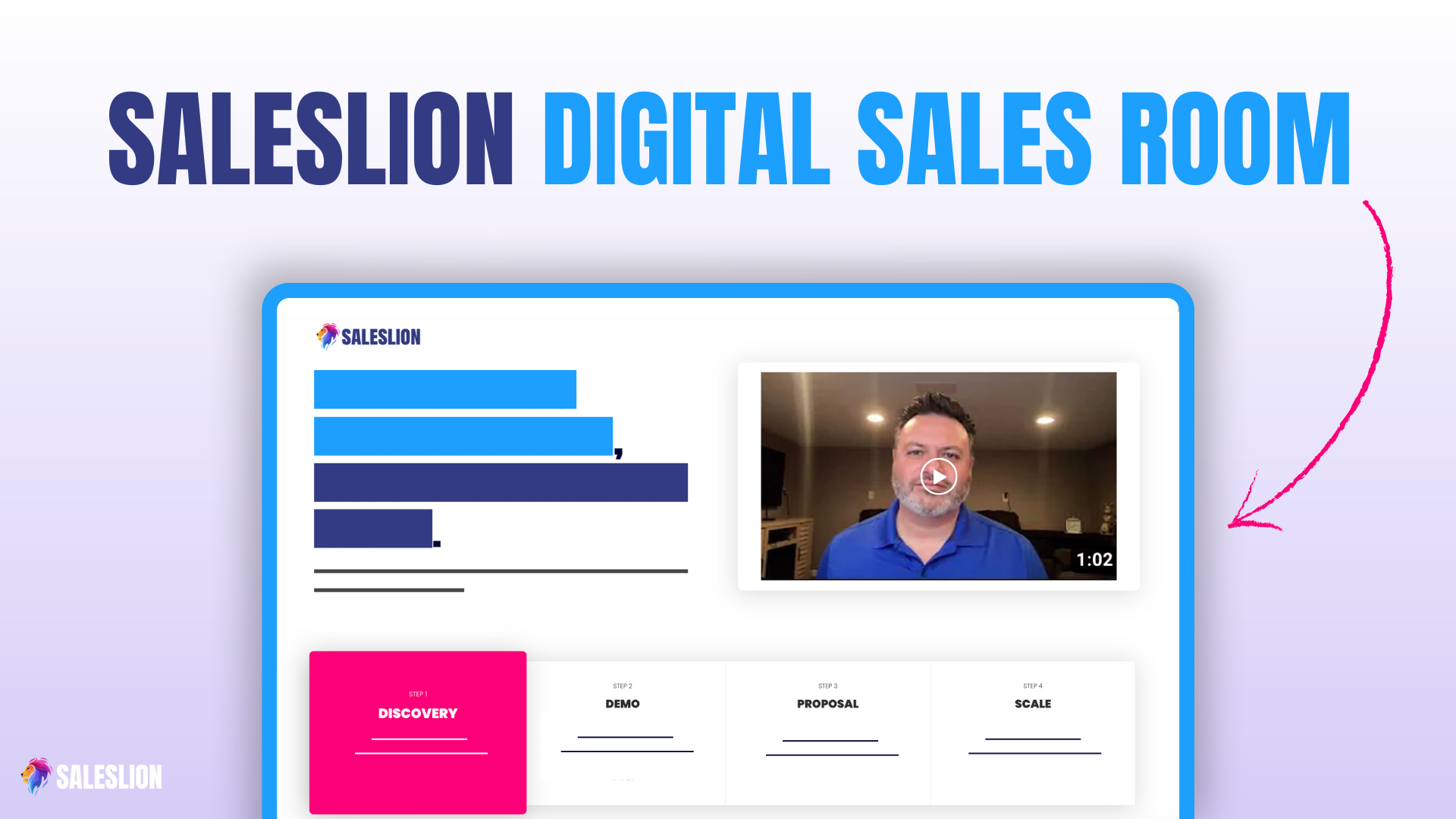Achieving true sales process optimization might seem like a complicated endeavor. But with a sales optimization strategy, it suddenly becomes a simple task.
By no means does this mean that sales optimization is easy or that it can be accomplished without intentionality, planning, and consistent efforts. But with a strategy, it is no longer such a daunting process.
To help you on your journey of developing a killer sales optimization strategy to kickstart your B2B sales process, we’ve put together the 6 crucial steps and tactics that you need in order to build an effective strategy.
Today we are going to dive deeper into sales process optimization, uncovering the 6 steps to achieving it, and exploring how the Saleslion digital sales room effectively enhances each.
TL:DR
If you don’t have time to read the full article, check out this video by our very own Tony Zayas to learn about the 6 key steps to improving your sales process.
What Is Sales Process Optimization?
So, before we go any further, what is sales process optimization?
In simple terms, it is the action of enhancing your current sales process to make it more efficient, effective, and productive for both your customers and your company.
With the right strategies, your B2B sales team can close deals faster, increase revenue, and improve customer experience.
Whether it involves streamlining sales processes, scaling revenue, or enhancing the customer journey, the art of optimizing the sales process serves as a compass for B2B companies aspiring to revolutionize their sales.
Organizations can adopt a wide range of sales optimization tactics to elevate their sales game, spanning from fine-tuning upper-funnel functions for enriched lead generation to refining discovery calls, ensuring the seamless communication of their complex solutions.
Yet, while the precise strategies of the sales process optimization blueprint may differ among companies, all forms of sales optimization strive toward a common goal: a more refined, efficient sales process that drives increased revenue.
Why Is Sales Process Optimization Important?

In an article about how to optimize the sales process, it states that sales process optimization is vitality important for B2B companies for 3 key reasons:
- Increased ROI: Firstly, sales process optimization is crucial for B2B companies seeking to boost their ROI. By identifying areas for improvement within each sales stage, your business gets more value from its resources. This knowledge of where you can improve ensures the sales process aligns with what the audience wants and leads to more deals and increased ROI for growth and innovation.
- More Conversions: In B2B sales, conversions keep businesses thriving. Optimizing the sales process revitalizes this crucial element. A refined process acknowledges customer needs, allowing sales teams to connect personally and persuasively. This leads to more genuine connections and, in turn, higher conversions.
- Improved Efficiency: Finally, efficiency is key for steady growth. With sales process optimization, your B2B company can streamline operations, allocate resources wisely, and eliminate bottlenecks. This efficiency accelerates deal closures and lets sales teams focus on important tasks like building relationships and addressing customer needs.
6 Steps to Improving Your Sales Process
So now that you know the aim of a sales optimization strategy and why sales process optimization is so important for your B2B company, let’s explore the 6 steps to improve your sales process.
Make Sure You Understand Your Customers
The first step to improving your sales process is ensuring that you have a clear understanding of who exactly your customers are and what their needs are.
If you have not identified a target audience or haven’t even created an ideal customer profile or buyer persona, then this is the perfect opportunity to revolutionize your sales efforts.
Understanding your customers is vital for customer satisfaction, competitive advantage, and effective product improvement.
Differentiate Yourself From Competitors and Establish Your Value Proposition
Not only should you understand your customers, but your customers should also understand you.
Especially in such competitive markets, differentiation is one of the most effective ways to stand out from the crowd.
Ask yourself questions to clearly define and establish your value proposition. The questions below are all great examples of questions you should be able to answer while creating your brand voice and differentiating yourself.
How are we different from the competition?
Why should customers buy from us?
What unmet needs are we addressing?
What unique value do we offer?
Differentiation in both your messaging and sales process will ensure that the right leads enter the sales funnel and that you are able to close deals more effectively.

Personalize the Sales Experience for Each Customer
Now that you know exactly who you are selling to and your customers know who you are and why you are different, it’s time to personalize the sales experience.
Personalization in the sales process is important for several reasons. But one of the most important reasons is that it helps solidify long-lasting relationships and trust between customers and companies.
If your prospects know that you are interested in serving them personally and customizing your solution to best fit their needs, they are more likely to convert to paying customers and refer your business to others.
Personalization is a key element of any effective sales optimization strategy.
Streamline Your Sales Process By Prioritizing Speed
An article about sales process optimization perfectly explained, slow and steady wins the race. Just not the sales race.
If your sales team is taking a long time to respond to customer questions or share necessary documents, your prospects will likely find a competitor that will get their problems solved quicker and more efficiently.
By streamlining your sales process and removing any unnecessary steps, you ensure that prospects recognize your invaluable commitment to service.
If you want your sales pipeline to always be flowing towards closing deals, prioritizing speed is a great way to achieve that.
Keep Your Messaging and Branding Consistent to Build Trust
While this slides somewhat into the world of marketing, consistent messaging and branding is another key step to improving your sales process.
A study by Edelman found that 81% of consumers need to trust a brand to consider buying. And if your messaging, from social posts to discovery calls, is not consistent, it will be very difficult for your prospects to begin to see your solution as trustworthy and valuable.
When creating your sales optimization strategy, ensure that both marketing and sales remain consistent. This consistency will ensure that people know that you are who you say you are.
Use Data and Analytics to Make Data-Driven Decisions
The final, and perhaps most important, step in improving your sales process is to use data and analytics to make data-driven decisions.
In any effective strategy, data and analytics are necessary. A sales optimization strategy is no different.
Using data is important because it doesn’t just allow you to anticipate customer problems, it also allows you to gain insights into which parts of your sales process are working and which parts are not.
How the Saleslion Digital Sales Room Can Enhance Each Step
In classic Saleslion fashion, we aren’t just going to give you tips and tricks to developing a killer sales optimization strategy, we are also going to give you the tools to make it happen.
The Saleslion digital sales room is a sales enablement platform designed to simplify complex sales processes, enhance personalization, engage customers more effectively, and increase close rates.

This sales enablement tool is able to do all of this with several features embedded within its platform: priority boards, mutual action plans, pricing calculators, and more.
Comprehension – Priority Boards
The priority board tool, also known as a ranking board, can effectively help sales teams better understand their customers by enabling documentation and evaluation of prospect priorities very early on in the sales process.
Also, by enhancing discovery calls, this tool ensures collaborative use to optimize the sales process for buyer needs.
Overall, this tool effectively enables sales professionals to gain a comprehensive understanding of their prospects so that they can customize their solutions for each prospect’s specific needs.
Differentiation – Digital Sales Room
The digital sales room itself is an invaluable tool for differentiating yourself from the competition.
Firstly, because so few sales processes are interactive and engaging for customers, having a collaborative, personalized, and enhanced sales interaction will immediately set you apart from the crowd.
With the benefits of digital sales rooms, you will be able to demonstrate to customers that you are willing to go the extra mile to provide value and quality service.
Additionally, because digital sales rooms allow B2B companies to communicate their complex solutions in simple ways, your prospects will easily be able to learn about your company and your solution.
Personalization – Solutions Boards
Similarly to priority boards, solutions boards allow sales teams to document the specific needs and wants of their customers. With this information, they can further personalize the sales experience and customize the solution.
These boards also allow for collaboration between the company and the customer to define an implementation plan for the solution that accommodates the customer’s specific schedule.
These boards enhance sales process transparency, clarifying what prospects will receive post-deal closure and how the solution will be implemented during onboarding.
Speed – Pricing Calculators
This interactive tool within the digital sales room allows customers to find a solution that fits their budget and unique wants and needs.
Because the customer has a better sense of exactly the solution they will be receiving, along with how much it will cost, the sales process is able to be better streamlined. Additionally, this heightened transparency gives sales reps more opportunities to build trusting relationships with prospects.
Consistency – Document Sharing
The document-sharing feature within digital sales rooms is key for maintaining brand consistency throughout the sales process.
With digital sales rooms, sales and marketing teams can collaborate to ensure that each digital sales room contains the most up-to-date and on-brand resources for customers to consume.
This consistency builds trust throughout the sales process, making it easier for prospects to convert to paying customers.
Data-Driven – Digital Sales Room Analytics
The final feature digital sales rooms have to enhance the steps to achieving a killer sales optimization strategy is analytics and tracking.
This feature is incredibly beneficial as it allows sales teams to track in real time what customers are doing and which tools within the digital sales room have the highest engagement.
Key Takeaways
Sales process optimization is incredibly important for B2B businesses. From enhancing ROI to streamlining the pipeline to driving more conversions it is crucial to build a sales optimization strategy to achieve that desired sales process optimization for your company.